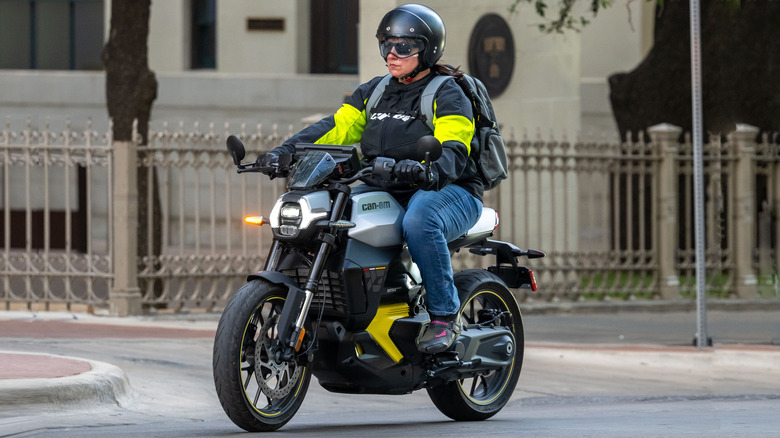
Mike Emery/Align Media
Even though Can-Am isn’t known for motorcycles — not now, not yet — they aren’t flying blind. It’s commonly believed the top powersports brand in North America has never had a motorcycle on the market… unless you’re young enough to disregard the ’70s. In fact, Can-Am’s first product was a two-wheeler, introduced in 1973. Shortly after, the company shifted to a focus on motorsports and ATVs, and the motorcycle was discontinued in 1987. The Pulse and Origin pave the proverbial way for electrification at BRP (Bombardier Recreational Products, Can-Am’s corporate parent) and are the company’s first mass-produced electric ride-on playthings. Eventually, Can-Am plans to expand to a family of EV motorcycles.
Advertisement
The new Can-Am EV motorcycle has been teased since 2022, and it’s now on sale, and it’s pretty good. With the new Pulse and Origin, Can-Am may not have initiated this market, but these bikes are worthwhile additions. The Pulse is conceived as an urban commuter bike; the Origin is for all-terrain trips. Both are designed with everyday riding in mind, though Can-Am knows they aren’t for everyone.
Can-Am’s stated goal is to bring passion to the EV market. It’s doable, by bringing new people into the hobby and making bikes that are fun to ride, with what Can-Am says is a combination of innovation and functionality that inspire each other. That’s a lot of marketing speak. The fun part is that it works.
Advertisement
Pulse and Origin design
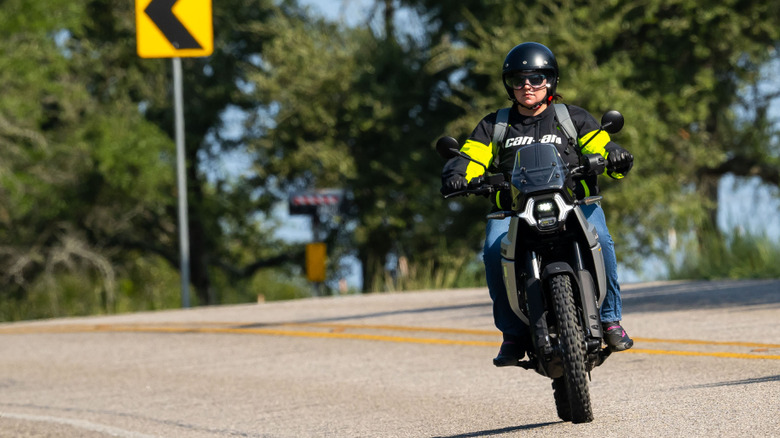
Mike Emery/Align Media
These Can-Am bikes hail from the biggest design studio in Canada, so it’s only fitting that their styling is inspired by a snowy owl — believe the designer-speak, and they combine the sharpness and stealth of a predator, and the aerodynamics and elegance of a champion flyer. More practically, both bikes share the main structure: that resembles the tank design of a traditional motorcycle, for familiarity and comfort, though the battery rides low in the frame.
Advertisement
Both models are available in three main colors — black, white, and silver — though in reality, they’re all mostly black with high-visibility neon yellow accents. LED signature lighting is visible from the front and sides. The Pulse is low, sleek, and quick-looking; the Origin is tall and bouncy and ready to rumble, and features more neon accents.
Can-Am has a comprehensive line-up of accessories, too, including cargo management with a proprietary lockable, bolt-on system shared with other Can-Am vehicles. A simple glovebox with a USB port is perfect for locking up a smartphone and other small essentials.
Zippy power
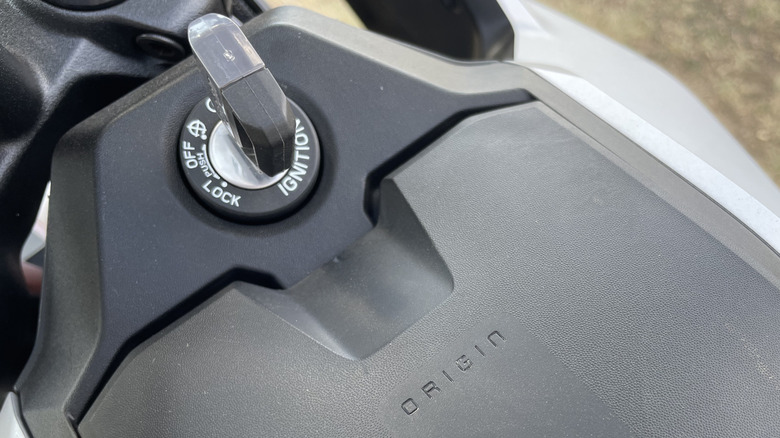
Cherise Threewitt/SlashGear
Though the drivetrain technology might seem all new to consumers accustomed to gas-powered bikes, it’s been put through the rigors already. The Pulse and Origin feature a 47-horsepower motor and an 8.9-kWh liquid-cooled battery, with a 6.6-kW onboard charger and a J1772 charging port. The drivetrain components have been tested in extreme climates, and the battery was adapted from some Can-Am snowmobiles. The battery is integrated into the bikes’ structure, which helps them benefit from a low center of gravity, proven to be a performance benefit in electric cars. A liquid-cooled battery system extends battery life, limiting the damage that exposure to extreme temperatures (known as thermal derating) can cause over time, while helping the bike run and charge as efficiently as possible.
Advertisement
Reverse is a handy feature, easily accessed by long-pressing the start button when in Drive.
Both bikes feature a silent chain final drive in an oil-sealed case. Again, Can-Am adapted this technology from its Ski-Doo snowmobiles, though it’s relatively new to the motorcycle world. It’s quiet and protected from debris — particularly valuable if using the Origin as intended — and the chain is fully submerged in oil, so it’s low maintenance. The chain case incorporates a magnet to collect any shavings from damaged metal. Can-Am notes that the bikes will need an oil service at the first 5,000 and 10,000 miles, which entails nothing more than draining and replacing the oil from the sealed case. At 25,000 miles, the service schedule recommends the case is opened so the chain can be checked for damage. These maintenance intervals are similar to a car, which may help increase the comfort level of first-time bike buyers.
Advertisement
Technology familiar from car dashboards
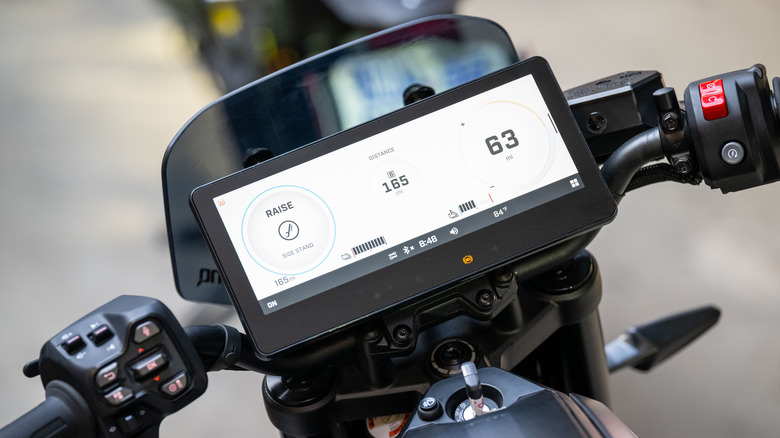
Mike Emery/Align Media
Both bikes feature a 10.25-inch display — much wider than it’s tall — with Apple CarPlay, designed to work with touchscreen-capable gloves. Your mileage may vary with regards to how well the touchscreen responds to non-compatible gloves, or bare fingertips, for that matter. The display also enables OTA (over-the-air) software updates when connected to Wi-Fi, and gives access to charging settings. Charging can also be controlled with the BRP Go app, which has added new features for the Pulse and Origin.
Advertisement
We weren’t able to test Apple CarPlay, since it requires a Bluetooth headset in addition to a compatible phone. According to Can-Am, this is Apple’s requirement, to reduce potential distractions and ensure safety. With a Bluetooth headset, Apple CarPlay can provide its usual functions, like play music, give navigation directions, and take voice commands.
On a related note, Can-Am says the company has rectified the issues that left Apple CarPlay nonfunctional on the 2024 Spyder three-wheeled bike, and says that those glitches won’t affect the Pulse or Origin.
Efficiency and regenerative braking
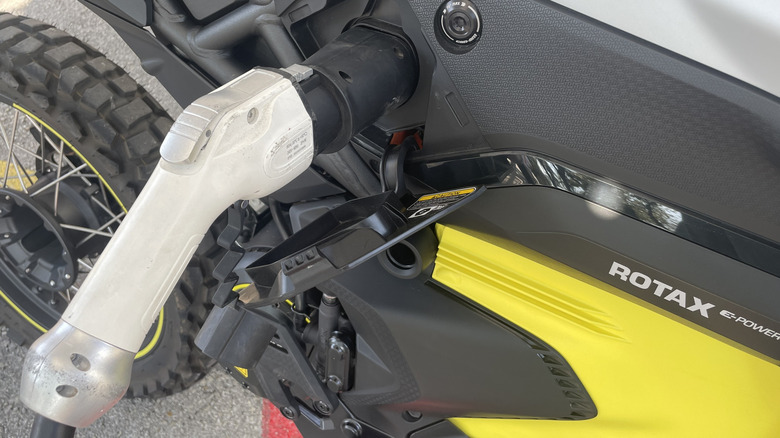
Cherise Threewitt/SlashGear
The Pulse, rated for up to 100 miles, and the Origin, rated for up to 90 miles, both feel optimistic. The range calculator adjusts over time by considering previous drive behavior, and adjusts in real time to show how current riding behavior affects range.
Advertisement
The bikes’ regenerative braking system could make a big difference there; it’s a cool but complex feature, and involves a learning curve. In all-electric mode, as well as many plug-in hybrid and regular hybrid cars, regenerative braking is a familiar technology. In short, it taps the vehicle’s electric motor to slow the vehicle down — effectively using the motor in reverse, as a generator — then sends that energy back to the battery to recapture some range.
It feels a little different in every vehicle, so there’s always a bit of adjustment, but where in cars the regen braking usually works through the brake pedal, with Can-Am’s bikes it’s activated through the throttle. There are three regenerative braking settings on the Pulse and Origin— Off, Min, and Max — and it’s controlled by twisting the throttle away from the rider. Depending on the setting, the bike will hit a soft or hard figurative wall, and some range will show up on the screen’s range gauge. It would be a fun feature to play with, learning to use regenerative braking in lieu of actual braking, and learning how to hypermile. On this short test, however, it demanded too much mental bandwidth to really get the hang of it. Can-Am notes that in focus groups and other consumer research, regenerative braking was the most-talked-about feature of these bikes.
Advertisement
Pulse ride impressions
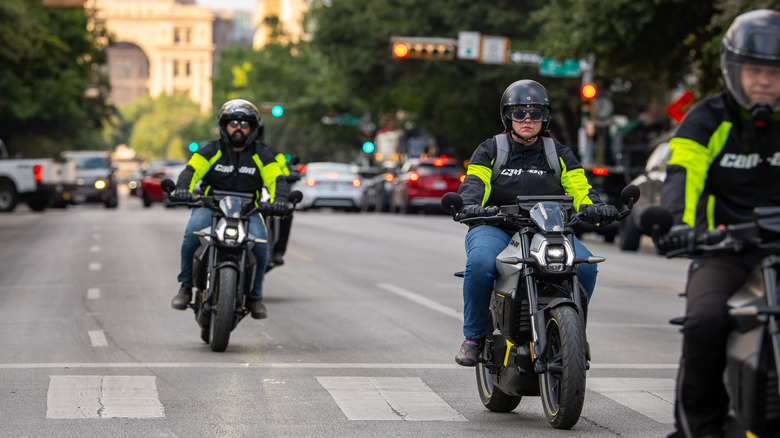
Mike Emery/Align Media
The Pulse feels light and nimble, easy to mount and to control. It’s highway capable, with quick acceleration and confidence-holding speed, though it’s designed as a city commuter. Our test route took us through both scenarios, and the Pulse didn’t fumble transitioning between the two. The Pulse is rated for a 3.8-second 0-60 time and a top speed of 80 mph, with 17-inch wheels with Dunlop Sportmax GPR-300 tires as standard. KYB front suspension ensures a smooth ride.
Advertisement
The Pulse has a low stance, is easy to mount, and offers a comfortable riding position. A passenger seat is available (and will come standard on European models).
The Pulse features Normal, Sport, Eco, and Rain modes, easily selectable through toggle switches near the left handlebar. The drive modes in both models adjust throttle response, and thus, traction (particularly for Rain and the Origin’s Off Road modes, discussed below). The modes do not affect transmission tuning, since the CVT is already designed to best respond to conditions on the fly.
It’s estimated for 80 miles of range in mixed riding and up to 100 miles in the city, though as we discovered that seems like a pipe dream.
Origin ride impressions
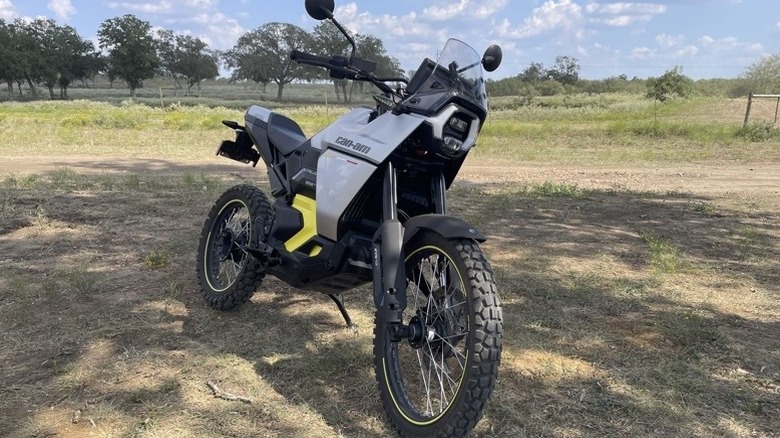
Cherise Threewitt/SlashGear
The Origin features the same powertrain as the Pulse and much of the same design, though it boasts a higher ride height courtesy of a full KYB suspension system with 10.8 inches of ground clearance and 10 inches of suspension travel. Thanks in part to its higher ride height, as well as its knobby Dunlop D605 tires — 21 inches up front and 18 in the rear — it certainly looks the part of an off-road bike. It’s half a second slower to 60 mph than the Pulse, and range estimates fall to 90 miles city, 71 miles combined.
Advertisement
In practice, both bikes fell far short of estimated range. Chalk that up to a number of factors — my inexperience riding an electric bike and hesitation to fully engage with regen braking; that we were traveling mostly at highway speeds though Can-Am says that isn’t really these bikes’ purpose and that such speeds will drain range like mad; and finally that on this particular September afternoon in Texas, temps hovered between 95 and 99 degrees, finally capping off at 108 in downtown Austin in the evening rush hour.
The Origin adds two Off-Road modes to the Pulse’s four modes, though I was unable to test them because the Origin was too tall for me to get confident enough on the trail. It’s light and easy to maneuver, but if both your feet can’t touch the ground, the Pulse is the better bet.
Advertisement
The EV bike use cases
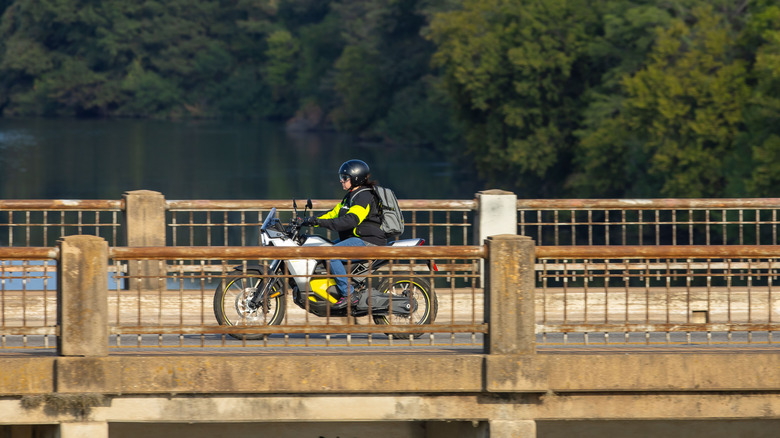
Mike Emery/Align Media
Though Can-Am was beaten to market by Zero and LiveWire, the Pulse and Origin have a few advantages over those competitors. They’re more affordable, which opens up to a wider potential audience and potential buyers that might not want or be ready to commit to bigger or more expensive bikes. In Europe, the likely buyer of a Pulse or Origin would use it as a primary source of transportation, while in the United States, it has value as transportation but is mostly for recreation.
Advertisement
There’s definitely benefit here for experienced motorcycle owners, though Can-Am sees these EV bikes as an addition to an existing stable, rather than a replacement. That’s largely because Can-Am realizes experienced riders are unlikely to want to switch completely to a clutch-free, twist-and-go bike, even if it makes a great choice for comfortable, efficient, emissions-free commuting. Also, buyers with space to keep multiple bikes will most likely have access to home charging.
The Origin has potentially even more appeal for a first bike, since it offers up accessible all-terrain riding without the complication of shifting, and it has brand appeal for new or beginning riders who might not have motorcycle knowledge or experience, but are familiar and comfortable with the Can-Am brand through its various other motorsports products.
Advertisement
Can-Am also perceives EV early adopters — at least, those willing to make the leap at a lower price point than rivals — as potential buyers. Then there’s the silent elephant in the room: without a gas engine, the hush of an EV motorcycle takes some getting used to. It’s pleasant for long country roads though can be unsettling in traffic.
Pricing and competition
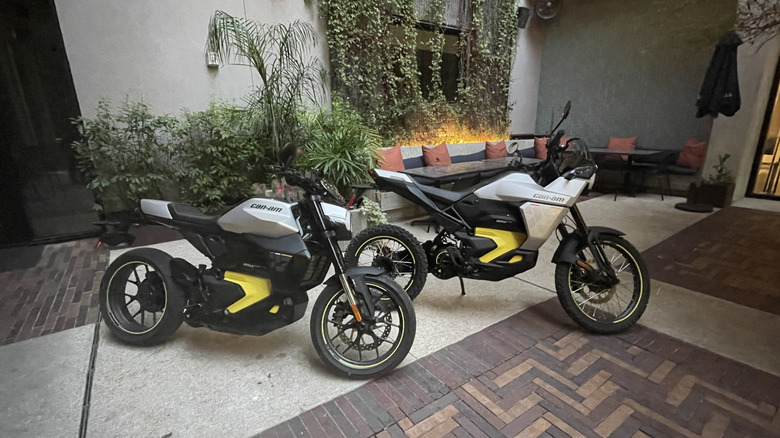
Cherise Threewitt/SlashGear
The 2025 Can-Am Pulse starts at $13,999 and the Origin starts at $14,499. Can-Am has two main competitors in this novel space. There’s LiveWire, the Harley-Davidson offshoot that distances itself from its Wisconsin-based parent with a four-bike lineup with California-inspired model names, and Zero, which offers three models in a total of eight trims.
Advertisement
LiveWire’s base bike, the $15,499 S2 Del Mar, is the closest rival to Can-Am, though it’s undercut by both the Pulse and Origin. LiveWire claims more power and range, but that’s fair for both the higher prices ($15,499 to $22,799) and the different audience (tourers rather than commuters).
Zero’s bikes start at $20,995 and go up from there, though they’re more powerful and have longer range. Most Zero bikes have top speeds well upwards of 100 mph, with the exception of the FX lineup, and range from 102 to 179 miles (again, the FX models are the outlier at the lower end). As such, there’s a decent argument that Can-Am is targeting a different market than Zero, for commuters who plan to charge daily.
Advertisement
Another noteworthy advantage is that Can-Am already has a strong dealer network, unlike LiveWire and Zero, which matters for service as well as for sales.
As far as comparing the Can-Am electric lineup to comparably priced and similarly capable gas bikes, there are so many options that it’s a fool’s game to explore them all. Based on my experience, Can-Am presents a compelling argument that the Pulse and Origin are fairly unique in being affordable electric motorcycles for newcomers, or a novel yet practical addition to the stable for established riders.
Can-Am Pulse and Origin Verdict
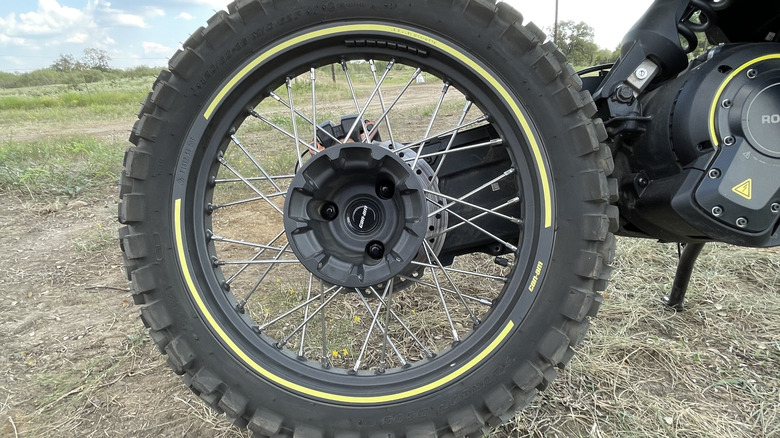
Cherise Threewitt/SlashGear
The Can-Am Pulse is a comfortable, easily accessible street bike. If I rode more, or even had a reasonable excuse to ride more, I could see it replacing my Honda Grom. I wouldn’t spend up for the additional features because, in base form, it’s a super comfortable option to go run errands and play in my urban neighborhood with garage parking and access to charging.
Advertisement
As much as I liked the Can-Am Origin, and would ultimately prefer it for a mere $500 over the Pulse, my legs would need to be a couple inches longer for it to be the viable option. I rode the Origin for the first leg of our street test, switched to the Pulse, and then back to the Origin for off-roading. At about 5-foot-7 with what I like to think is decent hip flexibility, the Origin was mildly uncomfortable to straddle and I could rest only part of one foot on level pavement. On our off-road test course, those limitations prompted me to test the basic rather than advanced trail.
These electric Can-Am bikes are comparably equipped, they’re equally stylish and functional, and over the course of ownership, the price difference between the two is negligible. If the Origin is comfortable and the all-terrain features are something you’d use, it’s worth the upcharge as well as the arguably negligible compromises to range and efficiency. If you have short legs and don’t need to traverse dirt or mud in your daily grind, the Pulse is the better pick. It’s comfortable, affordable, accessible, and easy to get acquainted with.
Advertisement